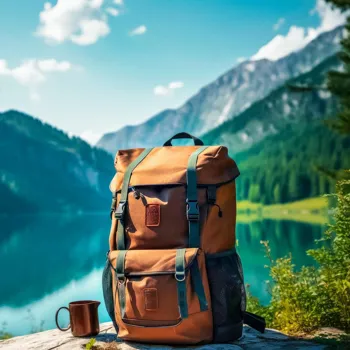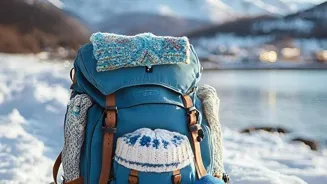Explore the 10 Must-Have Travel Essentials for Indian Adventurers! From backpacks to first-aid kits, gear up for a memorable journey across vibrant landscapes. Stay safe and comfortable with these essential
items. Read on to enhance your travel experience!
Are you ready to pack your bags and embark on an unforgettable adventure, exploring the diverse landscapes and vibrant cultures of India and beyond? Before you set off on your journey, it's crucial to ensure you're well-equipped with the right gear.

Whether you're planning a trek in the Himalayas, a road trip across Rajasthan, or a backpacking trip through Southeast Asia, having these ten essential items will enhance your experience and keep you safe and comfortable along the way.
So, grab a pen and paper, and let's dive into the ultimate packing list for every intrepid Indian traveller!
A Reliable Backpack
Your backpack is your home on the road, so invest in a durable and comfortable one. Look for features like adjustable straps, multiple compartments, and weather-resistant material. A good backpack should distribute weight evenly and provide easy access to your belongings.

Consider the size based on the length and type of your trip. For shorter trips, a 40-50 liter pack should suffice, while longer adventures may require a 60-70 liter pack. Remember to pack light and only bring what you truly need to avoid unnecessary strain on your back.
Before your trip, practice packing and carrying your backpack to ensure it feels comfortable and balanced, especially when fully loaded. When selecting a backpack, pay attention to the quality of the zippers and buckles, as these are often the first points of failure.
Choose a reputable brand known for its durability and customer support. Consider a backpack with a built-in rain cover to protect your belongings from unexpected downpours.
Versatile Clothing
Pack clothing that is lightweight, quick-drying, and easy to layer. Choose fabrics like merino wool or synthetic blends that wick away moisture and regulate body temperature. A few essential items include a comfortable pair of walking shoes, a waterproof jacket , and a hat or cap for sun protection.
When deciding on your clothing items, think about the climate of your destination and pack accordingly. Consider neutral colors that can be easily mixed and matched to create different outfits. This will help you minimize the number of items you need to pack.
It's also a good idea to bring a small laundry kit so you can wash your clothes on the go. This will further reduce the amount of clothing you need to pack and save you money on laundry services. Also, choose clothes that dont require any ironing.
Pick clothes that are flexible with weather changes.
First-Aid Kit
A well-stocked first-aid kit is a must-have, regardless of your destination. Include essentials like bandages, antiseptic wipes, pain relievers, anti-diarrheal medication, and any personal medications you require. Pack a small first-aid manual for guidance on treating common injuries and illnesses.
Consider including items specifically tailored to your destination, such as insect repellent for mosquito-prone areas or altitude sickness medication for high-altitude treks. Check the expiry dates of all medications before packing your kit.
It's also a good idea to learn basic first-aid skills before your trip. This will enable you to handle minor medical issues yourself and provide assistance to others in need. Customise your kit according to your requirements.
You can pack personal medicine with prescription, allergy medicines, mosquito repellent, and sun screen.
Power Bank
In today's digital age, a power bank is indispensable for keeping your devices charged on the go. Choose a power bank with sufficient capacity to charge your phone, camera, and other electronic devices multiple times. Look for features like multiple charging ports and fast charging capabilities.
Consider the weight and size of the power bank, especially if you're planning a long trek or backpacking trip. A power bank can be a lifesaver when you're in remote areas or during power outages. Always charge your power bank fully before embarking on your adventure.
Choose a power bank with a reputable brand and high safety ratings to avoid any potential hazards. Keep your personal devices charged at all times. While you are traveling, you might rely on maps or internet.
Water Bottle and Purification
Staying hydrated is essential, especially when travelling in hot or humid climates. Carry a reusable water bottle to reduce plastic waste and ensure you always have access to water. Consider a water filter or purification tablets for situations where clean drinking water is not readily available.

Always prioritize clean drinking water to prevent waterborne illnesses. Look for water bottles made from BPA-free materials to avoid any harmful chemicals leaching into your water. Consider a water bottle with a wide mouth for easy filling and cleaning.
Research the water quality in your destination and take appropriate precautions. Many countries have safe and easily accessible drinking water, while others may require you to filter or purify your water.
Navigation Tools
While GPS and smartphones are convenient, it's always wise to have backup navigation tools. A map and compass can be invaluable in areas with poor or no internet connectivity. Familiarize yourself with basic map reading and compass skills before your trip.
Consider downloading offline maps to your phone or tablet for use in areas without internet access. When hiking or trekking, always carry a topographical map of the area. A physical map and compass can be crucial in emergency situations, such as getting lost or encountering unexpected obstacles.
Consider attending a map reading and compass navigation course to enhance your skills. Remember that technology can fail, so it's always best to have a reliable backup plan. These navigation tools can prove to be truly helpful when one is not able to access internet or the phone is not working.
Make sure you are well aware of how it works.
Headlamp or Flashlight
A headlamp or flashlight is essential for navigating in the dark, especially when camping or exploring remote areas. Choose a lightweight and durable option with a long battery life or rechargeable batteries. Look for features like adjustable brightness settings and a waterproof design.
A headlamp is particularly useful as it allows you to keep your hands free. Carry extra batteries or a portable charger to ensure your light source doesn't run out of power. Always test your headlamp or flashlight before embarking on your trip to ensure it's working properly.
A good light source can be a lifesaver in emergency situations, such as getting lost or encountering wildlife after dark. One can use it at night while one needs to navigate and it will keep both your hands free.
Travel Adapter
If you're travelling internationally, a universal travel adapter is essential for charging your electronic devices. Choose an adapter that is compatible with the different types of electrical outlets in your destination. Look for features like surge protection and multiple charging ports.
Consider bringing a power strip to accommodate multiple devices. Check the voltage requirements of your devices before plugging them into a different electrical system. Using the wrong voltage can damage your electronic devices.
A travel adapter will allow you to stay connected and keep your devices charged regardless of your location. This can also be helpful, if you are using rented apartments and they may have a power cut. This can also be helpful if you visit to remote villages.
Multi-Tool
A multi-tool is a versatile tool that can come in handy in a variety of situations. Look for features like a knife, pliers, screwdriver, and bottle opener. Choose a lightweight and compact option that is easy to carry.
A multi-tool can be useful for repairing gear, preparing food, or dealing with unexpected challenges. Familiarize yourself with the different functions of your multi-tool before your trip. Practice using the tools safely and effectively.
A multi-tool can be a lifesaver in emergency situations, such as repairing a broken tent or fixing a flat tire. Its a pocket rocket, with multiple things under one umbrella which can prove to be helpful. This does not replace any main tool, but acts like a supporter.
Copy of Important Documents:
Make copies of your passport, visa, driver's license, and other important documents. Store the copies separately from the originals in case of loss or theft. Consider scanning your documents and storing them securely online. Share the copies with a trusted friend or family member.
Having copies of your documents will make it easier to replace them if they are lost or stolen. It can also help you prove your identity and citizenship. Keep both physical and digital copies of your documents. Always keep the digital documents in a secure password.
Sharing copies to your relatives at home will help, in case you need to prove your nationality.
AI Generated Content. Glance/InMobi shall have no liability for the content